List of AM cannabinoids
Alexandros Makriyannis is a professor in the Department of Medicinal Chemistry at Northeastern University, where his research group has synthesized many new compounds with cannabinoid activity. Some of those are:
| Name | Class | Ki at CB1 | Ki at CB2 | Selectivity | CLogP | Structure |
|---|---|---|---|---|---|---|
| AM-087 | Dibenzopyran | 0.43nM | 6.47 | 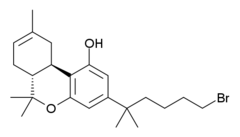 | ||
| AM-251 | Pyrazole derivative | 7.5nM | 7.08 | 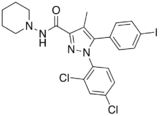 | ||
| AM-279 | ||||||
| AM-281 | ||||||
| AM-356 | 17.9nM | 868nM | 5.55 |  | ||
| AM-374 | ||||||
| AM-381 | ||||||
| AM-404 | 7.02 | 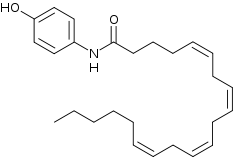 | ||||
| AM-411 | 6.80nM | 52.0nM | 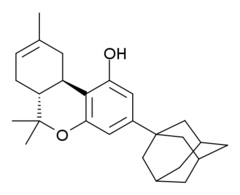 | |||
| AM-630 | 32.1nM | CB2 (165x) | 4.19 | 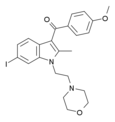 | ||
| AM-661 | ||||||
| AM-678 | 9.00nM ± 5.00 | 2.94nM ± 2.65 | 5.68 | 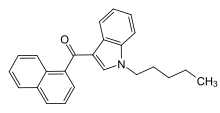 | ||
| AM-679 | 13.5nM | 49.5nM | 6.04 | 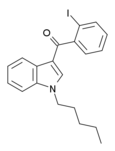 | ||
| AM-694 | 0.08nM | 1.44nM | CB1 (18x) | 5.54 | ||
| AM-735 | 8.9nM | 7.4nM | ||||
| AM-855 | 22.3nM | 58.6nM | 7.1 | 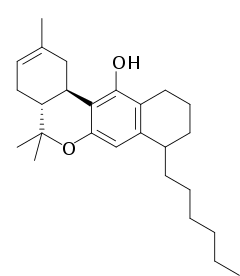 | ||
| AM-881 | 5.3nM | 95nM | ||||
| AM-883 | 9.9nM | 226nM | ||||
| AM-905 | 1.2nM | 5.3nM | 4.98 | 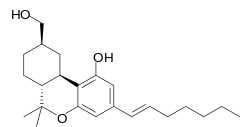 | ||
| AM-906 | 0.8nM | 9.5nM | 4.98 | 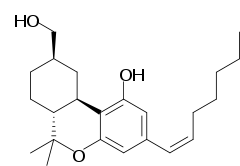 | ||
| AM-919 | 2.2nM | 3.4nM | 6.21 | 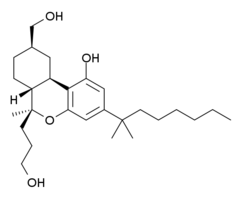 | ||
| AM-926 | 2.2nM | 4.3nM | ||||
| AM-938 | 1.2nM | 0.3nM | 5.92 | 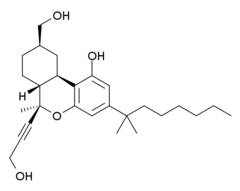 | ||
| AM-1116 | 7.4nM | |||||
| AM-1172 | ||||||
| AM-1220 | 3.88nM | 73.4nM | 4.73 | 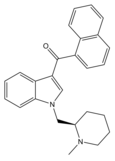 | ||
| AM-1221 | 52.3nM | 0.28nM | CB2 (187x) | 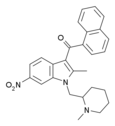 | ||
| AM-1235 | 1.5nM | 20.4nM | CB1 (13x) | 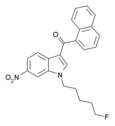 | ||
| AM-1241 | 3.4nM | CB2 (80x) |  | |||
| AM-1248 | 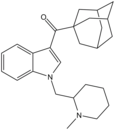 | |||||
| AM-1710 | Cannabilactone | CB2 (54x) | ||||
| AM-1714 | Cannabilactone | CB2 (490x) | 6.17 | 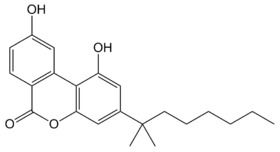 | ||
| AM-1902 | ||||||
| AM-2201 | 1.0nM | 2.6nM | 5.18 | 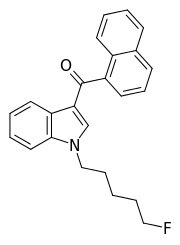 | ||
| AM-2212 | 1.4nM | 18.9nM | ||||
| AM-2213 | 3.0nM | 30nM | CB1 (10x) | |||
| AM-2232 | 0.28nM | 1.48nM | 4.75 | 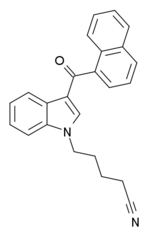 | ||
| AM-2233 | 1.8nM | 2.2nM | 5.09 | 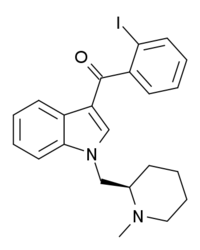 | ||
| AM-2389 | 0.16nM | CB1 (26x) | 6 | 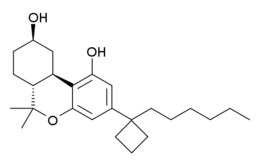 | ||
| AM-3102 | 33μM | 26μM | ||||
| AM-4030 | 0.7nM | 8.6nM | CB1 (12x) | 6.17 | 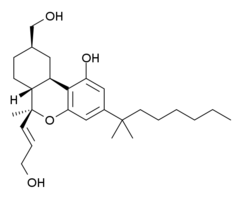 | |
| AM-4054 | 2.2nM | CB1 (40x) | ||||
| AM-4056 | 0.041nM | 6.51 | 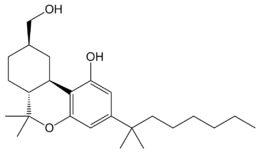 | |||
| AM-4113 | ||||||
| AM-6545 | 4.06 | 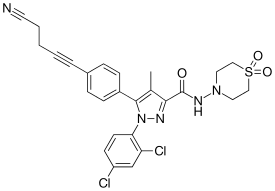 | ||||
- AM-087 — an analgesic CB1 agonist derived from Δ8THC substituted with a side chain on the 3-position, it has a Ki of 0.43nM making it roughly 100x as potent as THC.
- AM-251 — an inverse agonist at the CB1 cannabinoid receptor that is structurally related to SR141716A (rimonabant), but has a higher binding affinity with a Ki value of 7.5nM.[1]
- AM-279 — a Schedule I substance in Alabama.[2]
- AM-281 — N-(morpholin-4-yl)-1-(2,4-dichlorophenyl)-5-(4-iodophenyl)-4-methyl-1H-pyrazole-3-carboxamide[1]
- AM-356 — a synthetically created stable chiral analog of anandamide, it acts on the cannabinoid receptors with a Ki of 17.9nM at CB1 and 868nM at CB2.[3]
- AM-374 — palmitylsulfonyl fluoride[4]
- AM-381 — stearylsulfonyl fluoride
- AM-404 — an active metabolite of paracetamol (acetaminophen) and a likely inhibitor of fatty acid amide hydrolase (FAAH)
- AM-411 — an adamantyl-substituted derivative of Δ8THC, it is a potent and fairly selective CB1 full agonist with a Ki of 6.80nM. It is also a moderately potent CB2 agonist with a Ki of 52.0nM.
- AM-630 — a potent and selective inverse agonist for the cannabinoid receptor CB2, with a Ki of 32.1nM at CB2 and 165x selectivity over CB1, at which it acts as a weak partial agonist.
- AM-661 — 1-(N-methyl-2-piperidine)methyl-2-methyl-3-(2-iodo)benzoylindole[5]
- AM-678 — another name for JWH-018, it is a full agonist at both cannabinoid receptors with some selectivity for CB2.
- AM-679 — an iodobenzoylindole which acts as a moderately potent agonist for the cannabinoid receptors, with a Ki of 13.5nM at CB1 and 49.5nM at CB2.
- AM-694 — an iodobenzoylindole which acts as a potent and selective agonist for the CB1 cannabinoid receptor, with a Ki of 0.08nM at CB1 and 18x selectivity over the related CB2 receptor (1.44nM).[6]
- AM-735 — 3-bornyl-Δ8-THC, a mixed CB1 / CB2 agonist with Ki of 8.9nM at CB1 and 7.4nM at CB2.[7]
- AM-855 — an analgesic derivative of Δ8tetrahydrocannabinol, it is an agonist at both CB1 and CB2 with moderate selectivity for CB1, with a Ki of 22.3nM at CB1 and 58.6nM at CB2.
- AM-881 — a chlorine-substituted stereoisomer of anandamide whose Ki = 5.3nM at CB1 and 95nM at CB2.[3]
- AM-883 — an allyl-substituted stereoisomer of anandamide whose Ki = 9.9nM at CB1 and 226nM at CB2.[3]
- AM-905 — a potent and reasonably selective agonist for the CB1 cannabinoid receptor, with a Ki of 1.2nM at CB1 and 5.3nM at CB2.
- AM-906 — a potent and dodecally selective agonist for the CB1 cannabinoid receptor, with a Ki of 0.8nM at CB1 and 9.5nM at CB2.
- AM-919 — a potent agonist at both CB1 and CB2 with moderate selectivity for CB1, with a Ki of 2.2nM at CB1 and 3.4nM at CB2. It is a derivative of HU-210 and represents a hybrid structure between the classical and nonclassical cannabinoid families.
- AM-926 — a potent agonist at both CB1 and CB2 with moderate selectivity for CB1, with a Ki of 2.2nM at CB1 and 4.3nM at CB2. It is a derivative of HU-210 and represents a hybrid structure between the classical and nonclassical cannabinoid families.
- AM-938 — a potent agonist at both CB1 and CB2 with quadruple selectivity for CB2, with a Ki of 1.2nM at CB1 and 0.3nM at CB2. It is a derivative of HU-210 and represents a hybrid structure between the classical and nonclassical cannabinoid families.
- AM-1116 — a dimethylated stereoisomer of anandamide whose Ki = 7.4nM at CB1.[3]
- AM-1172 — an endocannabinoid analog specifically designed to be a potent and selective inhibitor of AEA uptake that is resistant to FAAH hydrolysis.
- AM-1220 — a potent and selective analgesic CB1 agonist (as racemate) with a Ki of 3.88nM at CB1 and 73.4nM at CB2, giving it 19x selectivity for CB1. (R) enantiomer has around 1000x higher affinity for CB1 than (S) enantiomer.[8][9]
- AM-1221 — a potent and selective CB2 agonist with a Ki of 0.28nM at CB2 and 52.3nM at CB1, giving it a selectivity of almost 187x.
- AM-1235 — a moderately CB1 selective agonist, with a Ki of 1.5nM at CB1 and 20.4nM at CB2, giving it a selectivity of around 13x.[10]
- AM-1241 — a potent and selective analgesic CB2 agonist with a Ki of 3.4nM at CB2 and 80x selectivity over CB1.[11]
- AM-1248 — a moderately potent agonist with some selectivity for CB1, containing an unusual 3-(adamant-1-oyl) substitution on the indole ring.
- AM-1710 — a CB2 selective cannabilactone with 54x selectivity over CB1.[12]
- AM-1714 — a CB2 selective cannabilactone with 490x selectivity over CB1.[12]
- AM-1902 — a nonclassical cannabinoid[13]
- AM-2201 — a potent agonist at both CB1 and CB2 with moderate selectivity for CB1, with a Ki of 1.0nM at CB1 and 2.6nM at CB2.
- AM-2212 — a potent agonist at both CB1 and CB2 with dodecal selectivity for CB1, with a Ki of 1.4nM at CB1 and 18.9nM at CB2.[5]
- AM-2213 — a potent agonist at both CB1 and CB2 with 10x selectivity for CB1, with a Ki of 3.0M at CB1 and 30nM at CB2.[5]
- AM-2232 — a potent agonist at both CB1 and CB2, with a Ki of 0.28nM at CB1 and 1.48nM at CB2.[10]
- AM-2233 — (R) enantiomer is potent and selective CB1 agonist used in 131I radiolabelled form to map distribution of CB1 receptors in brain.[14][15][16][17][18][19]
- AM-2389 — classical cannabinoid derivative with 26x selectivity for CB1.
- AM-3102 — an analog of oleoylethanolamide, the endogenous agonist for proliferator-activated receptor α (PPARα). It also acts as a weak cannabinoid agonist with Ki values of 33μM at CB1 and 26μM at CB2.
- AM-4030 — a potent agonist at both CB1 and CB2, it is dodecally selective for CB1, with a Ki of 0.7nM at CB1 and 8.6nM at CB2. It is a derivative of HU-210 and represents a hybrid structure between the classical and nonclassical cannabinoid families.
- AM-4054 — a potent but slow-onset agonist with CB1 affinity of 2.2nM and a 40x selectivity for CB1 over CB2.[20][21]
- AM-4056 — Another name for HU-243, it is a potent agonist at both the CB1 and CB2 receptors, with a binding affinity of 0.041 nM at the CB1 receptor.
- AM-4113 — a CB1 selective neutral antagonist.[22]
- AM-6545 — a peripherally selective silent antagonist of CB1 receptors.
See also
References
- Lan, Ruoxi; Lu, Qian; Fan, Pusheng; Gatley, John; Volkow, Nora D.; Fernando, Susanthi R.; Pertwee, Roger; Makriyannis, Alexandros (1999). "Design and synthesis of the CB1 selective cannabinoid antagonist AM281: A potential human SPECT ligand". AAPS PharmSci. 1 (2): 39–45. doi:10.1208/ps010204. PMC 2761119. PMID 11741201.
- "Alabama Senate Bill 333 - Controlled substances, Schedule I, additional synthetic controlled substances and analogue substances included in, trafficking in controlled substance analogues, requisite weight increased, Secs. 13A-12-231, 20-2-23 am'd". March 2014. Retrieved 28 September 2015.
- Selwood, D. (2009). "The Cannabinoid Receptors. Edited by Patricia H. Reggio". ChemMedChem. 4: 1949. doi:10.1002/cmdc.200900286.
- Pacher, P.; Bátkai, S; Kunos, G (2006). "The Endocannabinoid System as an Emerging Target of Pharmacotherapy". Pharmacological Reviews. 58 (3): 389–462. doi:10.1124/pr.58.3.2. PMC 2241751. PMID 16968947.
- Hongfeng Deng. Design and synthesis of selective cannabinoid receptor ligands: Aminoalkylindole and other heterocyclic analogs. PhD Dissertation, University of Connecticut, 2000.
- WO patent 200128557, Makriyannis A, Deng H, "Cannabimimetic indole derivatives", granted 2001-06-07
- Lu, D; Guo, J; Duclos, RI Jr; Bowman, AL; Makriyannis, A (Oct 2008). "Bornyl- and isobornyl-Delta8-tetrahydrocannabinols: a novel class of cannabinergic ligands". Journal of Medicinal Chemistry. 51 (20): 6393–9. doi:10.1021/jm8005299. PMC 3700413. PMID 18826296.
- D'ambra, T. (1996). "C-Attached aminoalkylindoles: potent cannabinoid mimetics". Bioorganic & Medicinal Chemistry Letters. 6: 17–22. doi:10.1016/0960-894X(95)00560-G.
- Willis, P. G.; Pavlova, O. A.; Chefer, S. I.; Vaupel, D. B.; Mukhin, A. G.; Horti, A. G. (2005). "Synthesis and Structure−Activity Relationship of a Novel Series of Aminoalkylindoles with Potential for Imaging the Neuronal Cannabinoid Receptor by Positron Emission Tomography". Journal of Medicinal Chemistry. 48 (18): 5813–22. doi:10.1021/jm0502743. PMID 16134948.
- US patent 7241799, Makriyannis A, Deng H, "Cannabimimetic indole derivatives", granted 2007-07-10
- Poso, A.; Huffman, J. W. (2008). "Targeting the cannabinoid CB2 receptor: modelling and structural determinants of CB2 selective ligands". British Journal of Pharmacology. 153 (2): 335–46. doi:10.1038/sj.bjp.0707567. PMC 2219524. PMID 17982473.
- Khanolkar, AD; Lu, D; Ibrahim, M; Duclos, RI Jr; Thakur, GA; Malan, TP; Porreca, F; Veerappan, V; Tian, X; George, C; Parrish, DA; Papahatjis, DP; Makriyannis, A (Dec 2007). "Cannabilactones: a novel class of CB2 selective agonists with peripheral analgesic activity". Journal of Medicinal Chemistry. 50 (26): 6493–500. doi:10.1021/jm070441u. PMID 18038967.
- Luk T, Jin W, Zvonok A, Lu D, Lin XZ, Chavkin C, Makriyannis A, Mackie K. Identification of a potent and highly efficacious, yet slowly desensitizing CB1 cannabinoid receptor agonist. Br J Pharmacol. 2004 Jun;142(3):495-500. PMID 15148260 DOI 10.1038/sj.bjp.0705792
- Deng H, Gifford AN, Zvonok AM, Cui G, Li X, Fan P, Deschamps JR, Flippen-Anderson JL, Gatley SJ, Makriyannis A (October 2005). "Potent cannabinergic indole analogues as radioiodinatable brain imaging agents for the CB1 cannabinoid receptor". Journal of Medicinal Chemistry. 48 (20): 6386–92. doi:10.1021/jm050135l. PMID 16190764.
- Hanuš, L. R. O.; Mechoulam, R. (2005). "Cannabinoid chemistry: an overview". Cannabinoids as Therapeutics. Milestones in Drug Therapy MDT. p. 23. doi:10.1007/3-7643-7358-X_2. ISBN 3-7643-7055-6.
- Shen CP, Xiao JC, Armstrong H, Hagmann W, Fong TM (February 2006). "F200A substitution in the third transmembrane helix of human cannabinoid CB1 receptor converts AM2233 from receptor agonist to inverse agonist". European Journal of Pharmacology. 531 (1–3): 41–6. doi:10.1016/j.ejphar.2005.12.026. PMID 16438957.
- Dhawan, J.; Deng, H.; Gatley, S. J.; Makriyannis, A.; Akinfeleye, T.; Bruneus, M.; Dimaio, A. A.; Gifford, A. N. (2006). "Evaluation of the in vivo receptor occupancy for the behavioral effects of cannabinoids using a radiolabeled cannabinoid receptor agonist, R-[125/131I]AM2233". Synapse. 60 (2): 93–101. doi:10.1002/syn.20277. PMID 16715483.
- Leung K (Dec 12, 2006). "R-2-[131I]Iodophenyl-(1-(1-methylpiperidin-2-ylmethyl)-1H-indol-3-yl)methanone". Molecular Imaging and Contrast Agent Database (MICAD) [Internet]. PMID 20641836.
- Pei, Y.; et al. (2008). "Ligand-Binding Architecture of Human CB2 Cannabinoid Receptor: Evidence for Receptor Subtype-Specific Binding Motif and Modeling GPCR Activation". Chemistry & Biology. 15 (11): 1207–1219. doi:10.1016/j.chembiol.2008.10.011. PMC 3700404. PMID 19022181.
- [Paronis CA, Thakur GA, Vemuri K, Makriyannis A, Bergman J. Effects of a Selective Cannabinoid Agonist and Antagonist on Body Temperature in Rats. The FASEB Journal. April 2007 21 (Meeting Abstract Supplement) A409. http://www.fasebj.org/cgi/content/meeting_abstract/21/5/A409]
- Paronis, C. A.; Thakur, G. A.; Bajaj, S.; Nikas, S. P.; Vemuri, V. K.; Makriyannis, A.; Bergman, J. (2012). "Diuretic effects of cannabinoids". Journal of Pharmacology and Experimental Therapeutics. 344 (1): 8–14. doi:10.1124/jpet.112.199331. PMC 3533417. PMID 23019138.
- Seely, KA; Prather, PL; James, LP; Moran, JH (Feb 2011). "Marijuana-based drugs: innovative therapeutics or designer drugs of abuse?". Molecular Interventions. 11 (1): 36–51. doi:10.1124/mi.11.1.6. PMC 3139381. PMID 21441120.
This article is issued from
Wikipedia.
The text is licensed under Creative
Commons - Attribution - Sharealike.
Additional terms may apply for the media files.